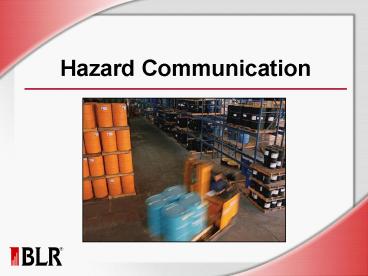Hazard Communication - PowerPoint PPT Presentation
1 / 32
Title: Hazard Communication
1
Hazard Communication
2
Session Objectives
- You will be able to
- Understand the hazards of materials in your
work area - Interpret information on warning labels
- Understand Online material safety data
sheets (MSDSs) - Protect yourself
- Respond to emergencies
3
Encounters with Hazardous Materials
- We encounter potentially hazardous materials
almost every day - Filling your vehicle with gasoline
- Cleaning the house
- Applying pesticides or insecticides
- Using solvents or acids at work
Many materials can cause injury or illness!
4
Encounters with Hazardous Materials (cont.)
- 30 million workersexposed or potentiallyexposed
to 650,000materials annually - 20,000 incidents ofexposure annually result in
lost workdays
5
Hazard Communication Law
- As an employer, we must provide you with
- A written hazard communication program
- A list of hazardous materials
- MSDSs (provided Online)
- Training
6
Hazard Communication Law (cont.)
- You must be able to
- Read labels and MSDSs
- Follow employer instructions and warnings
- Identify hazards before starting a job
- Participate in training
7
Types of Materials
- Solids
- Dusts, powders, and fumes
- Liquids
- Vapors and mists
- Gases
Image Credit Washington Dept. of Labor
Industries
8
Physical Hazards
- Flammable
- Explosive
- Reactive
9
Health Hazards
- Short-term effects
- Headache, dizziness, skin irritation
- Long-term effects
- Liver or lung damage or cancer
- Materials with health hazards include those
labeled as - Corrosive
- Toxic
10
Hazardous Materials At This Facility
- Types of hazardous materials
- Locations of hazardous materials
11
How Hazardous Materials Enter Your Body
- Skin absorption and eye contact
- Inhalation
12
How Hazardous Materials Enter Your Body (cont.)
- Ingestion (eatingcontaminated food)
- Penetration through a cut, puncture, or injection
13
How Hazardous Materials Affect Your Body
Match the term with its explanation below.
Chronic Effects Acute Effects Dosage
Amount of hazardous material you are exposed to
- Short-term effects that usually disappear when
you are no longer exposed
Long-term effects that develop over a period of
exposure
14
Exposure Limits
- Permissible exposure limit (PEL)
- Threshold limit value (TLV)
- Time-weighted average (TWA)
- Short-term exposure limit (STEL)
15
Whats Wrong Here?
- Worker assigned to clean screens
- Given a cleaner, brush, and rag
- Identify the hazard(s)
16
What PPE Should He Use?
- Protective clothing
- Face shield
- Goggles
- Respirator
- Gloves
17
Chemical Hazards
- Do you understand your right to know?
- Any questions about hazards posed by materials?
18
Read the Label
Review animation
- Identity of the material
- Manufacturer contact information
- Physical/health hazards
- Special handling
- PPE recommendations
- First aid, fire response,and spill cleanup
19
Whats on the Label?
- The product label shows
- The name of the material
- The manufacturer
- Miscellaneous safety information
- Hazard warnings
- List of hazardousingredients
- The product label shows
- The name of the material
- The manufacturer
- Miscellaneous safety information
- Hazard warnings
- List of hazardousingredients
Image Credit University of Utah, Physics
Department
20
NFPA Labeling Systems
- Blue Health hazard
- Red Flammability
- Yellow Instability
- White Other hazards
- Numbers 0 (No Hazard) to 4 (Extreme Hazard)
21
In-Plant Labeling
- Use for
- Secondary containers
- Stationary process containers or vessels
- Portable or temporary containers
- Include tags and process batch sheets
22
Information Resource The MSDS
- Is a written description of a hazard related to
a material - Describes the risks, precautions, and remedies to
exposure - Must be readily available to you
- Read the MSDS before working with any material!
Northshore Technical College provides MSDS
information online via the NTC website.
23
The MSDS(cont.)
- Identity of material and manufacturer
- Ingredients
- Hazards
- First-aid and fire-fighting measures
24
The MSDS(cont.)
- Accidental release
- Handling and storage
- Exposure controls and PPE
- Physical and chemical properties
- Stability, reactivity, toxicity
- Ecological and disposal info
- Transportation, regulatory, and other info
25
Labels and MSDSs
- Do you understand about properties of materials,
labeling, and the contents of MSDS?
26
PPE Physical Protection
- Face shields/goggles
- Gloves
- Foot protection
- Head protection
- Aprons or full bodysuits
27
PPE Respiratory Protection
- During installation of engineering controls
- During maintenance
- Nonroutine tasks
- Emergency response
- When other controls are inadequate
- When other controls are not feasible
28
Emergency Response to Spills
- Eyes Flush with water for 15 minutes
- Skin Wash with soap and water, remove
contaminated clothing - Inhalation Move to fresh air
- Swallowing Get emergency medical assistance
29
Emergency Response to Spills or Leaks
- Evacuate the area
- Notify a supervisor or the emergency response
team - Stay away
30
What Should Be Done?
- Receive right-to-know training
- Access MSDS (online)
- Read labels
- Wear PPE
31
Key Points to Remember
- Identify hazards.
- Read labels and MSDSs.
- Follow warnings and instructions, or ask your
supervisor if in doubt. - Use the correct PPE.
- Practice sensible, safe work habits.
- Learn emergency procedures.
32
Northshore Technical
College
- Hazardous Materials and Hazardous Waste Program
- This acknowledges that I have received and read,
this date, a copy of the Northshore Technical
College Hazardous Materials and Hazardous Waste
Program within the Safety Manual and a copy of
the Hazard Communication Powerpoint, effective
10/13/2010, and I understand that I am required
to abide by the terms and provisions of this
Program as a condition of employment with the
office of Risk Managements Loss Prevention
Program, and Northshore Technical College. - Date ___________________ Employee Name
__________________________ - ___________________________________
- Employee Signature































